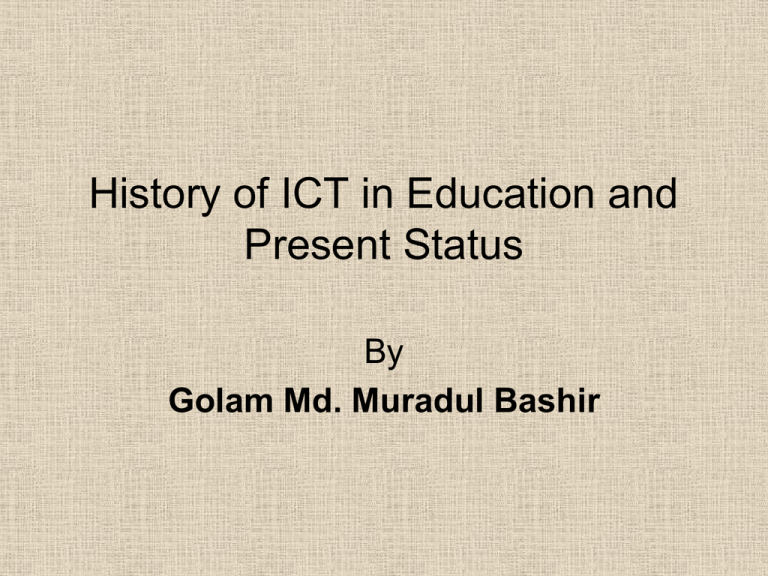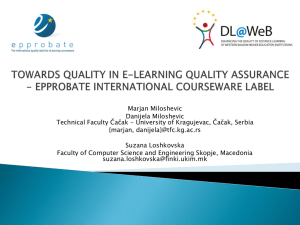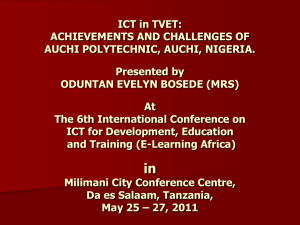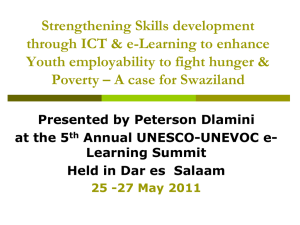History of ICT in Education - Bangladesh University of Engineering
advertisement

History of ICT in Education and Present Status By Golam Md. Muradul Bashir The word 'e-Learning' In October 1999, during a CBT Systems seminar in Los Angeles, A strange new word was used for the first time in a professional environment – ‘eLearning’ The word 'e-Learning' Associated with 'online learning' or 'virtual learning', This word was meant to qualify "a way to learn based on the use of new technologies allowing access to online, interactive and sometimes personalized training through the Internet or other electronic media (intranet, extranet, interactive TV, CD-Rom, etc.), so as to develop competencies while the process of learning is independent from time and place". Early learning aid A Roman piece from a place near Trier. It dated from 200 A.C. and shows a school where the teacher is sitting in the middle and two students are sitting around him, reading a parchment role. At the right a student is arriving with his tablet on which he could write. This technique (writing slate) was used within European schools till around 1950. Early learning aid Dr. Marcel Mirande is mentioning in his book ‘The Unstoppable rise of the Learning machine’ that The writing slate actually looks like, and maybe is, the equivalent of the modern laptop. He also states that the meaning and importantance of the writing slates was very clear. It has to be used to develop writing skills. Nowadays we are still developing a clear and balanced view on the new learning aids like laptops. writing slate modern laptop An e-learning timeline First modern distance course Isaac Pitman taught shorthand in Great Britain via correspondence in the 1840s (shorthand is an abbreviated, symbolic writing method that improves speed of writing or brevity as compared to a normal method of writing a language). He decided to start a distance course and was sending assignments to his students by mail and they completed the 'homework' and sent it back to him. History of Elearning In 1924 The Ohio State University professor Sidney Pressey invented the “Automatic Teacher”, the first device in electronic learning This device allowed students to tests themselves. History of Elearning Then, in 1954, BF Skinner, a Harvard Professor, invented the “teaching machine Skinners Programmed Instruction was very popular. At this very moment, programmed instruction is popular when it comes to (digital) self study courses. History of Elearning It wasn’t until 1960 however that the first computer based training program was introduced to the world. This computer based training program (or CBT program) was known as PLATO-Programmed Logic for Automated Teaching Operations. It was originally designed for students attending the University of Illinois History of Elearning Stanford University psychology professors began using computer aided instruction to teach math US Department of Defense commissioned ARPANET to create the Internet Computer mouse and GUI are invented to define ‘modern computing’ History of Elearning Personal computer begins with Macintosh, Online communities begins sharing informations If is the dawn of a new era in learning Virtual learning environments begins History of Elearning Business begins rolling out elearning courses as a central way to train workers Authoring tools are more accessible than ever Wide range of online learning opportunities are available A new way of learning inspired by social media You tube, Twitter, open online courses, Skype To connect, share information and learn from each other are found everywhere Four major phases in the history of using computers in education (1) Late 1970’s – early 1980’s: programming, drill and practice; (2) Late 1980’s – early 1990’s: computer based training (CBT) with multimedia; (3) Early 1990’s: Internet-based training (IBT); (4) Late 1990’s – early 2000: eLearning; (5) Late 2000: Social software + free and open content. Late 1970’s – early 1980’s: programming, drill and practice Math teacher was teaching also the new school subject called in Finnish “ATK” The abbreviation stand for “automated data processing” – and used Nokia MikroMikko There were not many software at all, There were the MS Basic for programming and naturally that was what the ATK lessons were almost all about Late 1970’s – early 1980’s: programming, drill and practice The academical reason to teach programming was not to train programmers, but the believe that it will develop students’ logics and math skills, as it most likely does The software were very simple drill and practice exercises for math and language learning. Late 1970’s – early 1980’s: programming, drill and practice These exercises didn’t help much students to reach any deeper understanding They were mainly simulating students’ short term memory and “trial, error, trial, error, trial, past” kind of activity Anyway these programs kept the wild children quiet (for a while) when teacher was teaching those who were more into programming Late 1980’s – early 1990’s: computer based training (CBT) with multimedia Same point when the multimedia computers, with advanced graphics and sound came to the mass markets Claim that the drill and practice exercises failed to teach much because they didn’t contain multimedia It was said that students would learn if they could watch animations in colours, small video clips and then do the exercises Late 1980’s – early 1990’s: computer based training (CBT) with multimedia This was the golden era of CD-ROMs and multimedia computers This combination was seriously expected to have a huge impact on the ways we learn The times were good for CD-ROM producers and of multimedia PC manufacturers Late 1980’s – early 1990’s: computer based training (CBT) with multimedia The pedagogical mantra behind this phase was that human are different and some students learn better by watching movies / animations and listening audios whereas some learn better by reading or watching still images The drill and practice component (now in colours) was kept in there, too Late 1980’s – early 1990’s: computer based training (CBT) with multimedia The multimedia CD-ROMs didn’t either get people to deep learning and understanding They failed to be useful almost in all other study subjects than language learning where Part of the study work of many people really requires hard practicing and repetition (vocabulary, grammar etc.) (3) Early 1990’s: Internet-based training (IBT) The third wave or hype of using computer in education came with the raise of the World Wide Web The failure of CD-ROMs were claimed to be related to the challenges to update the content in the CD-ROMs The promoters of the new paradigm claimed that information changes so fast that one should update it almost every day The solution is here: the Internet and the Internet-based training (3) Early 1990’s: Internet-based training (IBT) At this point computer-based training was brought to Internet, but again without the multimedia All you could do on Internet, that time, was text and pictures and some early experiments with animations, video and audio. Pretty fast it was noticed that clicking and reading e-learning course materials online didn’t make people very smart And again some people claimed that the problem was the lack of multimedia (3) Early 1990’s: Internet-based training (IBT) The educational ideas behind Internet-based training were not pedagogical at all The purpose and reason to promote it was the believe that it is cost-efficient as there were no more travelling to training or absence from workplace Finally it was not that cost-efficient at all In the end of the day there was very little under the bottom line – people didn’t learn much (4) Late 1990’s – early 2000: eLearning The Internet-based training got mature in late 1990’s and early 2000 in a form of e-learning The hype(publicity) around e-learning is a kind of classical example of creating needs Thousands of websites, articles and companies made it clear for all somehow related to education that this is something you must be involved it (4) Late 1990’s – early 2000: eLearning The IT managers of thousands of educational institutions and organizations were asked by the educational experts to come up with e-learning solutions and companies were happy to help the IT managers. The e-learning industry was build, even though it was not proven that anyone (except the IT managers) needed these products. The markets for e-learning courses and especially for Learning Management Systems (LMS) were created. (4) Late 1990’s – early 2000: eLearning The pedagogical thinking around the e-learning is closely related to the computer-based training. The point is to deliver courses for students. Later on the learning platform developers has become more aware that learning requires social activities among the learners themselves and the learner and the teacher(s). Still the user interfaces of the LMS systems are at least implicitly telling you that you should first read the content and if there is something you do not understand you may ask your peers or your teacher. (4) Late 1990’s – early 2000: eLearning On the other hand the e-learning field is nowadays so wide that it is hard to say what is the pedagogical thinking behind it. E-learning is no more one. It could be said that all the earlier paradigms live inside the e-leaning plus some clues of the future: social software and open content. (5) Late 2000: Social software + free and open content I really hope that in the late 2000 social software and free and open content will make a real breakthrough in the field of educational technology. Blogs and wikis have already brought web back to its original idea: simple tool for your personal notes that are easily accessible and even editable by your peers and your potential peers. (5) Late 2000: Social software + free and open content Such projects as the GNU-GPL, Creative Commons, Wikipedia and Open courseware have shown that free content benefits all – and that people are willing to contribute to the common good. Digital content is such that when you give it away you do not loose it yourself. This makes giving much easier for many people. (5) Late 2000: Social software + free and open content The pedagogical thinking behind the social software and the free and open content can be located to the social constructivist theory and cultural-historical psychology. “Any true understanding is dialogic in nature” wrote Mikhail Bakhtin and Lev Vygotsky wrote that “all higher [mental] functions originate as actual relations between human individuals”. (5) Late 2000: Social software + free and open content Learning with computers is not about programming or drill and practice, nor about multimedia, nor about fast updating or costefficiency – it is all about people sharing ideas. Courseware Courseware is a term that combines the words ‘course’ with ‘software’ Courseware can include: Material for instructor-led classes Material for self-directed computer-based training (CBT) Web sites that offer interactive tutorials Material that is coordinated with distance learning, such as live classes conducted over the Internet Videos for use individually or as part of classes OpenCourseWare OpenCourseWare movement started in 1999 when the University of Tübingen in Germany published videos of lectures online The OCW movement only took off, however, with the launch of MIT OpenCourseWare at the Massachusetts Institute of Technology (MIT) in October 2002. OpenCourseWare The movement was soon reinforced by the launch of similar projects at Yale, the University of Michigan, and the University of California Berkeley. MIT's reasoning behind OCW was to "enhance human learning worldwide by the availability of a web of knowledge” OpenCourseWare MIT stated that it would allow students (including, but not limited to its own) to become better prepared for classes so that they may be more engaged during a class. Since then, a number of universities have created OCW projects modeled after MIT's, some of which have been funded by the William and Flora Hewlett Foundation edX Ten years after the US debut of OCW, in 2012 MIT and Harvard University announced the formation of edX, a massive open online course (MOOC) platform to offer online university-level courses in a wide range of disciplines to a worldwide audience at no charge. edX Goals Expand access to education for everyone Enhance teaching and learning on campus and online Advance teaching and learning through research Our principles Not for profit Open source platform Collaborative Financially sustainable edX This new initiative was based on MIT's "MITx" project, announced in 2011, and extends the concepts of OCW by offering more structured formal courses to online students, including in some cases the possibility of earning academic credit or certificates based on supervised examinations. A major new feature of the edX platform is the ability for students to interact with each other and with teachers in online forums. In some cases, students will help evaluate each other's work, and may even participate in some of the teaching online. Problems A problem is that the creation and maintenance of comprehensive OCW requires substantial initial and ongoing investments of human labor. Effective translation into other languages and cultural contexts requires even more investment by knowledgeable personnel. This is one of the reasons why English is still the dominant language, and fewer open courseware options are available in other languages. Americas Brazil Fundação Getulio Vargas (FGV Online) Universidade Estadual de Campinas [6] Mexico Universidad de Monterrey, 2007[7] Americas USA This listing is roughly in the order of adoption of OCW principles. Massachusetts Institute of Technology (MIT), 2002 University of California, Berkeley Stanford University Princeton University University of Pennsylvania University of Michigan Harvard University Yale University Caltech Americas The following are not directly affiliated with a specific university: Academic Earth - private owned Khan Academy - non-profit Students Circle Network - peer to peer Coursera - venture capital financed[8] Udacity - venture capital financed[9] edX - non-profit Education Portal - non-profit Asia China OpenCourseWare originally initiated by MIT and the Hewlett Foundation, began movement in China in September, 2003, when MIT and the Internet Engineering Task Force (IETF) joined together with the Beijing Jiaotong University to organize an OpenCourseWare conference in Beijing. As a result of this conference, 12 universities petitioned the government to institute a program of OpenCourseWare in China. This group included both some of the most prestigious universities in China, as well as the Central Radio and Television University, which is China’s central open university, covering more than 2 million students Asia India The National Programme on Technology Enhanced Learning (NPTEL) is a Government of India sponsored collaborative educational programme. By developing curriculum-based video and web courses the programme aims to enhance the quality of engineering education in India. It is being jointly carried out by 7 IITs and IISc Bangalore, and is funded by the Ministry of Human Resources Development of the Government of India. Asia India Flexilearn is a very useful open course portal. It was initiated by Indira Gandhi National Open University, and apart from providing free course materials, Flexilearn also provides opportunities to enroll oneself for a course and appear for exam conducted by university and thereby get certification. Asia Japan OpenCourseWare originally initiated by MIT and the Hewlett Foundation, was introduced and adopted in Japan. In 2002, researchers from the National Institute of Multimedia Education (NIME) and Tokyo Institute of Technology (Tokyo Tech) studied the MIT OpenCourseWare, Leading them to develop an OCW pilot plan with 50 courses at Tokyo Institute of Technology in September Later, in July 2004, MIT gave a lecture about MIT OpenCourseWare at Tokyo Tech that prompted the first meeting of the Japan OCW Alliance. Europe Germany Netherlands University of Tübingen, 1999 SlideWiki.org (developed at University of Leipzig) Delft University of Technology, 2007 Turkey Middle East Technical University Middle East In the United Arab Emirates, a discussion, led by Dr. Linzi j. Kemp, American University of Sharjah, has begun about sharing teaching and learning materials (‘open course ware’) through a community of educators and practitioners There is growing availability of high quality and free open access materials shared between universities e.g. MIT (USA). Middle East We are also exposed to an example of resource sharing through ‘The Open University (UK), OpenLearn’ platform. Kemp (2013) proposes that teaching and learning will be enhanced when across institutions of higher education, we work together to bring our shared knowledge into classrooms. Furthermore, when we open up this platform to include practitioners e.g. Employers, then the relationship with industry will further ensure teaching and learning is available and beneficial for a wider community. What in Bangladesh? An Integrated Online Courseware Design Approach by G. M. M. Bashir et al. in NCICIT 2013 Organized by CUET, 21 November Organized by CUET, 21 November Present Status of Online Courseware Most of the courseware only for UG students A few for PG students No courseware available for primary level No courseware for disable students Absence of content clustering technique for course material Present Status of Online Courseware Animated video very important for science courses As for example, for medical student: movable or animated image or video very helpful for realizing blood circulation through heart Simulation s/w link essential for electrical or network related courses But most of the courseware are developed without considering theses things Present Status of Online Courseware We have done survey on 9 courseware Different courseware have different courses with different course material The ‘is present’ survey on different coursewares’ course material give a tremendous status As for example: Status (is present) of Animated Video Status (is present) of Link Status (is present) of Interactive Simulation Area Wise Status (is present) of Animated Video Present Status of Online Courseware These are the only ‘is present’ survey on different courseware’s course material Whereas individual topic should be enriched with proper course material Survey on specific topic will give more accurate status Also different courseware have own structure (not following any general structure) Virtual university A virtual university provides higher education programs through electronic media, typically the Internet The goal of virtual universities is to provide access to the part of the population who would not be able to attend a physical campus, for reasons such as distance — where students live too far from a physical campus to attend regular classes; and the need for flexibility — some students need the flexibility to study at home whenever it is convenient for them to do so. Virtual university Program delivery in a virtual university is administered through information communication technology such as web pages, e-mail and other networked sources. Where professors give televised lectures As virtual universities are relatively new and vary widely, questions remain about accreditation and the quality of assessment. Virtual university The Open University in the United Kingdom was the world’s first successful distance teaching university It was founded in the 1960s on the belief that communications technology could bring high quality degree-level learning to people who had not had the opportunity to attend campus universities Virtual university The idea for a “wireless university” was first discussed at the BBC (British Broadcasting Corporation) by the educationalist and historian J.C. Stobbart. From these early beginnings more ideas came forth until finally the Labour Party under the leadership of Harold Wilson formed an advisory committee to establish an Open University. Virtual university With the goal of bringing higher education to all those who wanted to access it, the committee came up with various scenarios before settling on the name Open University. The first idea floated in the UK was to have a “teleuniversity” which would combine broadcast lectures with correspondence texts and visits to conventional universities. In the “teleuniversity” scenario courses are taught on the radio and television and in fact many universities adopted the use of this technology for their distance education courses. Virtual university The name “teleuniversity” morphed into the "University of Air” which still had the same goal of reaching the lower income groups who did not have access to higher education. The name “University of Air” did not stick and by the time the first students were admitted in January 1971 the name had become what it is today “Open University”. OU proved that it was possible to teach university-level courses to students at a distance. Virtual university By 1980, total student numbers at OU had reached 70,000 and some 6,000 people were graduating each year. The 1980s saw increased expansion continue as more courses and subject areas were introduced; as the importance of career development grew, so the university began to offer professional training courses alongside its academic programmes. By the mid-nineties the OU was using the internet. As of 2008, more than 180,000 students were interacting with OU online from home. Virtual university A number of other universities were involved in the late eighties in pioneering initiatives and experiments were conducted between Victoria University in New Zealand, the University of Hawaii, Ohio State University and Waseda University To try and conduct classes and courses at an international level via telecommunications. This led to the concept of a Global Virtual University. Online degree Accreditation The goal of educational accreditation, according to the United States Department of Education, is to ensure that programs provided by institutions of higher education meet acceptable levels of quality ENQA, the European Association for Quality Assurance in Higher Education, describes the role of external quality assurance in education as one that "combines both accountability for the reassurance of the public and an objective and developmental role for enhancing quality in institutions". Online degree Accreditation In the area of online education, it is important to avoid unaccredited diploma mills that offer fake degrees, as these are unfortunately common. Students seeking valid online degrees should obtain proof of accreditation from an appropriate national or regional accrediting body Problem Base Learning An Animated Pedagogical Agent to Support ProblemBased Learning by Laysa Mabel de Oliveira et al., MAY 2013 presents an approach based on an animated pedagogical agent and three other agents for the detection of passive students and for the recommendation of learning objects in accordance with the students’ context to improve the learning process of PBL Problem Base Learning “Work in Progress: A Model for Facilitating Problem Based Learning” is done by Deirdre A. N. Hunter et al., 2012 “Work in Progress - A Problem-Based Learning Approach for Systems Understanding in the MSU AES Program” by Jon Sticklen et al., 2011 “Problem-Based Learning and Adaptive Expertise” by Jeffrey E. Froyd, 2011 Problem Base Learning “On Implementation of Problem-Based Learning in Engineering Education: Thoughts, Strategies and Working Models” is done by Waddah Akili, 2011 “An Ill-Structured PBL-Based Microprocessor Course Without Formal Laboratory” by Jungkuk Kim et al., 1997 “Problem-Based Learning in Wind Energy Using Virtual and Real Setups” by David Santos-Martin , 2011 Technology Based Learning Supporting Accessible Technology-Enhanced Training: The eAccess2Learn Framework is done by Demetrios G. Sampson, 2011 LaaN: Convergence of Knowledge Management and Technology-Enhanced Learning by Mohamed Amine Chatti et al., 2012 Teacher Tool for Visualization and Management of a Technology-Enhanced Learning Environment by Ralph Jayson E. Dagdag et al., 2011 Design of a Virtual Reality Based Adaptive Response Technology for Children With Autism by Uttama Lahiri, 2012 Outcome-based Learning “In-Service Teaching Assistant Training (InsTAT) for Engineering and Computer Science Graduate Students in Hong Kong: A BlendedLearning Approach” by Kai-Pan Mark, Dimple R. Thadani et al., 2011 “Development of FYP Online System for Outcome Based Education” by Abdul Mutholib et al., 2011 “Guidelines For The Final Year Project Assessment In Engineering” by Elena Valderrama et al., 2009 WikiProject: A Survey of ICT in Education for India and South Asia: Bangladesh National ICT Policy, 2002: In order to accelerate use of ICT in every sector in terms of information generation, utilization and applications the government has formulated a National ICT Policy, which has been approved by the Cabinet on 7 October 2002. In this policy participation of private sectors with government sector to develop this sector has been encouraged. This Policy aims at building an ICT-driven nation comprising of knowledgebased society. WikiProject: A Survey of ICT in Education for India and South Asia: Bangladesh National ICT Policy, 2008 (Proposed): The Government took an initiative in May 2008 to review the National ICT Policy 2002 and formed a 17-member Review Committee. The committee and its working group met all together 15 times over a period of four months to complete the task. WikiProject: A Survey of ICT in Education for India and South Asia: Bangladesh During this period, about 70 representatives from different sectors representing academia and public and private sectors invested over 1,000 man-hours to review the existing National ICT Policy and related documents to prepare recommendations befitting the current and foreseeable future needs of the nation. WikiProject: A Survey of ICT in Education for India and South Asia: Bangladesh The proposed National ICT Policy 2008 has incorporated all the ingredients of the National ICT Policy 2002 in a structured manner with requisite updates necessitated by developments since 2002. The revised policy has also incorporated new policy directions in line with the ever changing technological advancements in this area. The most remarkable changes that have been made in the revised National ICT Policy are: 1) a methodical framework of the policy document; and 2) inclusion of planned action items in conformity with policies and strategies. WikiProject: A Survey of ICT in Education for India and South Asia: Bangladesh National ICT Policy, 2009 (Approved): The Government of the People's Republic of Bangladesh further approved a National ICT Policy 2009 on 1st April, 2009 Regional Initiatives






